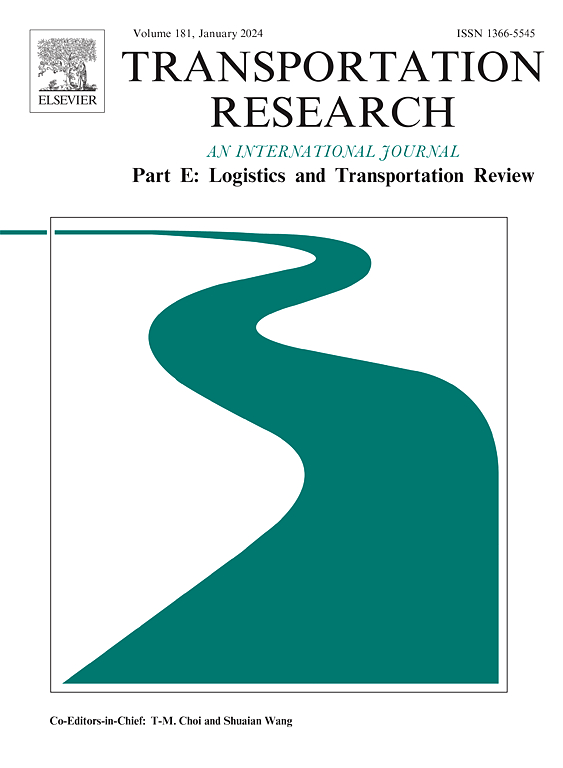Retrofit or new construction? Strategic budget allocation to improve transportation network redundancy under uncertain disruptions
IF 8.8
1区 工程技术
Q1 ECONOMICS
Transportation Research Part E-Logistics and Transportation Review
Pub Date : 2025-04-15
DOI:10.1016/j.tre.2025.104131
引用次数: 0
Abstract
Enhancing transportation network redundancy is an effective approach to proactively improving network resilience and mitigating the consequences of potential disruptions. This research addresses a route diversity redundancy-oriented strategic transportation network planning problem that involves the integration of two typical means: (1) constructing new infrastructure (e.g., road segments and bridges) and (2) retrofitting existing infrastructure. The two means differ in their mechanisms, effectiveness, and costs. To determine the optimal budget allocation between the two means, we establish a stochastic programming model that minimizes the expected loss of network redundancy (measured by network-level efficient routes) under uncertain disruptions. To overcome challenges due to the non-explicit redundancy formulation and the exponentially growing solution space, we provide an approximation algorithm to efficiently solve the model. Model extensions to include practical concerns, such as planners’ preferences for new construction and fairness in O-D-level redundancy, are also discussed. Using the 0–1 knapsack transformation, we theoretically elucidate the tradeoffs and priorities in retrofitting and new construction under varying disruption probabilities and cost disparities between the two means. We show the features of the model solutions and the applicability of the method using a 16-node network and the realistic Winnipeg network. We demonstrate that the model flexibly adjusts the budget allocation ratio between new link construction and link retrofitting under various conditions of disruption probability, cost disparity and budget level, effectively leveraging their complementary advantages to enhance network redundancy. In conditions with low disruption probabilities, low ratios of new link construction cost to retrofitting cost, and sufficient budgets, the scheme tends to favor new link construction. However, increasing the allocation for constructing new links — while beneficial for redundancy in the normal state — may conflict with reducing redundancy loss under disruptive events. Notably, we identify a critical budget threshold beyond which redundancy loss transitions from positive to negative, offering insights for determining appropriate budget levels. The proposed mathematical framework and numerical findings may provide practical support for planners in justifying redundancy-oriented decision-making (e.g., project prioritization), contributing to advancing efforts toward resilient urban infrastructure planning.
改造还是新建?不确定干扰下改善交通网络冗余的策略预算分配
增强交通网络冗余是主动提高网络弹性和减轻潜在中断后果的有效方法。本研究解决路线多样性冗余导向的战略交通网络规划问题,涉及两种典型方法的整合:(1)建设新的基础设施(如路段和桥梁)和(2)改造现有基础设施。这两种方法在机制、有效性和成本上有所不同。为了确定两种方法之间的最优预算分配,我们建立了一个随机规划模型,该模型在不确定中断下最小化网络冗余的预期损失(由网络级有效路由测量)。为了克服非显式冗余公式和指数增长的解空间所带来的挑战,我们提供了一种近似算法来有效地求解模型。还讨论了模型扩展,以包括实际问题,如规划者对新建筑的偏好和o - d级冗余的公平性。利用0-1背包变换,从理论上阐明了在不同中断概率和成本差异下改造和新建的权衡和优先级。我们以16节点网络和实际的温尼伯网络为例,展示了模型解的特点和方法的适用性。研究表明,该模型在不同的中断概率、成本差异和预算水平条件下,能够灵活调整新建和改造链路的预算分配比例,有效地发挥两者的互补优势,增强网络冗余度。在中断概率较低、新建线路成本与改造成本之比较低且预算充足的情况下,方案倾向于新建线路。然而,增加用于构建新链路的分配虽然有利于正常状态下的冗余,但可能与减少中断事件下的冗余损失相冲突。值得注意的是,我们确定了一个关键的预算阈值,超过这个阈值,冗余损失从正到负转变,为确定适当的预算水平提供了见解。所提出的数学框架和数值结果可能为规划人员提供实际支持,以证明冗余导向决策(例如,项目优先级)的合理性,有助于推进弹性城市基础设施规划的努力。
本文章由计算机程序翻译,如有差异,请以英文原文为准。
求助全文
约1分钟内获得全文
求助全文
来源期刊
CiteScore
16.20
自引率
16.00%
发文量
285
审稿时长
62 days
期刊介绍:
Transportation Research Part E: Logistics and Transportation Review is a reputable journal that publishes high-quality articles covering a wide range of topics in the field of logistics and transportation research. The journal welcomes submissions on various subjects, including transport economics, transport infrastructure and investment appraisal, evaluation of public policies related to transportation, empirical and analytical studies of logistics management practices and performance, logistics and operations models, and logistics and supply chain management.
Part E aims to provide informative and well-researched articles that contribute to the understanding and advancement of the field. The content of the journal is complementary to other prestigious journals in transportation research, such as Transportation Research Part A: Policy and Practice, Part B: Methodological, Part C: Emerging Technologies, Part D: Transport and Environment, and Part F: Traffic Psychology and Behaviour. Together, these journals form a comprehensive and cohesive reference for current research in transportation science.

 求助内容:
求助内容: 应助结果提醒方式:
应助结果提醒方式:


